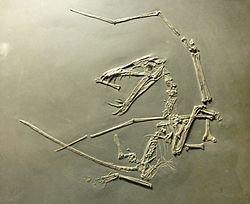Archosauromorphs
Crocodylomorphs
New taxa
| Taxon | Novelty | Status | Author(s) | Age | Unit | Location | Notes | Images |
|---|---|---|---|---|---|---|---|---|
| Aeolodon [2] | Gen. nov. | Valid | von Meyer | Kimmeridgian | Solnhofen Formation | A teleosaurid, named for Crocodilus priscus . |  | |
Pterosaurs
- Georg Wagler argued that pterosaurs represented a distinct class of aquatic vertebrates that he called Gryphi. Like Collini, Wagler thought that pterosaurs swam underwater using their forelimbs as flippers. [3]
New taxa
| Taxon | Novelty | Status | Author(s) | Age | Unit | Location | Notes | Images |
|---|---|---|---|---|---|---|---|---|
| Ornithocephalus banthensis [4] | Sp. nov. | Valid | Theodori | Toarcian | Posidonia Shale | Later renamed Dorygnathus banthensis |  | |
Other archosauromorphs
New taxa
| Taxon | Novelty | Status | Author(s) | Age | Unit | Location | Notes | Images |
|---|---|---|---|---|---|---|---|---|
| Protorosaurus speneri [2] | Gen. et sp. nov. | Valid | von Meyer | Guadalupian, 260–251 mya | Pirambola Formation | One of the most primitive archosauromorphs. Previously considered to be related to Prolacerta within Prolacertiformes, but now a new genus shows that they were in fact not closely related. [5] |  | |